
Albert Bryant Jr. is a retired United States Army brigadier general, best known for service as the Chief of Western Hemisphere Operations during and in the aftermath of the September 11 attacks and for his tenure as the Assistant Division Commander of the 4th Infantry Division at the time of the division's detection and capture of deposed Iraqi president Saddam Hussein. Bryant also served as the Deputy Commander of Fort Knox, Kentucky, and the United States Army's Armor School. As Chief of Staff of NATO's Kosovo Force (KFOR), Bryant was the highest ranking American general on the KFOR leadership team in the lead up to Kosovo independence.
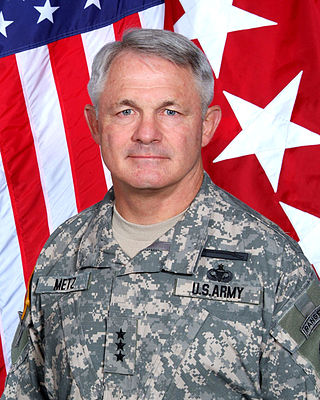
Thomas Fredric Metz is a retired lieutenant general in the United States Army. Metz retired from the Army in Jan 2010 after more than 40 years of active military service. His tour of duty prior to retirement was as the director, Joint Improvised Explosive Device Defeat Organization., leading the DOD organization tasked with finding and fielding ways to defeat the IED threat. Previously he was the deputy commanding general and chief of staff, U.S. Army Training and Doctrine Command. Previous to that assignment he was commanding general of the U.S. III Corps and Fort Hood. He assumed command of III Corps on 7 February 2003.
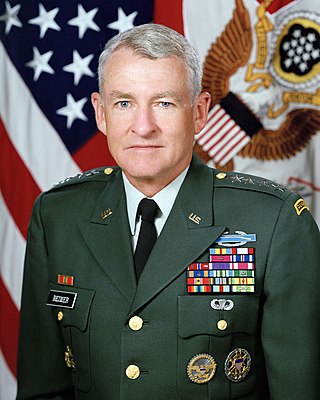
Dennis Joe Reimer is a retired general of the United States Army, who served as the 33rd Chief of Staff of the Army from June 20, 1995, to June 21, 1999. He is also a graduate of Ranger and Airborne school.

Lieutenant General Robert T. Clark is a retired United States Army officer. His last assignment was as the Commanding General, Fifth United States Army which he commanded from December 5, 2003 to December 2006.
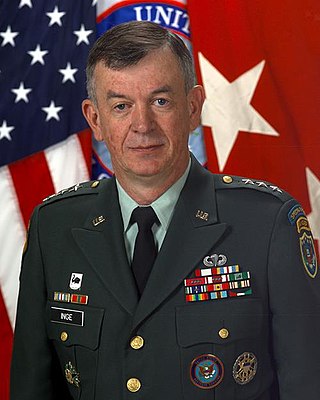
Lieutenant General Joseph Richard Inge was an officer of the United States Army. He served as Deputy Commander, United States Northern Command, and Vice Commander, United States Element, North American Aerospace Defense Command, headquartered at Peterson Air Force Base, Colorado in 2007. He retired in 2007, after a 38-year career.

Lieutenant General Michael S. Tucker is a retired United States Army general who served Commanding General of the First United States Army from 2013 until 2016. He formerly served as the Commanding General of the 2nd Infantry Division.

Thomas Francis Healy Jr. was a U.S. Army general and former commandant of the Army War College.
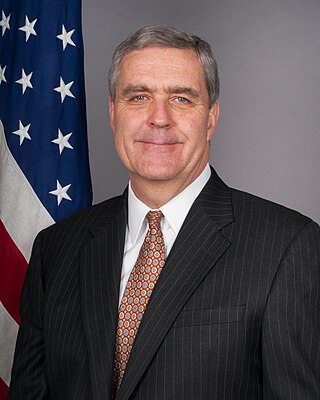
Lt. Gen. Douglas Edward Lute is a retired United States Army lieutenant general and public servant who served as the United States permanent representative to NATO from 2013 to 2017. He was nominated for the post by President Obama on May 23, 2013, confirmed by the Senate on August 1, 2013 by voice vote, and assumed his position on September 3, 2013.

Stephen M. Twitty is a retired lieutenant general in the United States Army. Twitty assumed command of First United States Army on July 15, 2016, relinquishing command to become deputy commander of United States European Command on 9 August 2018. Previously, he was commanding general of Fort Bliss and the 1st Armored Division. Twitty was awarded the Silver Star during Operation Iraqi Freedom. Noted for his relationship with journalist David Bloom, who was embedded with his battalion during the invasion of Iraq in 2003, Twitty has served in five combat deployments, including tours in the Gulf War, Afghanistan, Iraq, and Kuwait. He has commanded at the company, battalion, and brigade level during the wars in Iraq and Afghanistan. Twitty is a graduate of South Carolina State University and a member of the Omega Psi Phi fraternity. He was inducted into the South Carolina State University ROTC Hall of Fame in 2009, and selected as one of the university's Distinguished Alumni in 2004.

Paul John Kern is a retired United States Army general and businessman. He served as Commanding General of the United States Army Materiel Command from October 2001 to November 2004. He became President and Chief Operating Officer of AM General LLC on August 1, 2008.

Louis Carson Wagner Jr. is a retired United States Army four-star general who served as commanding general, United States Army Materiel Command from 1987 to 1989.
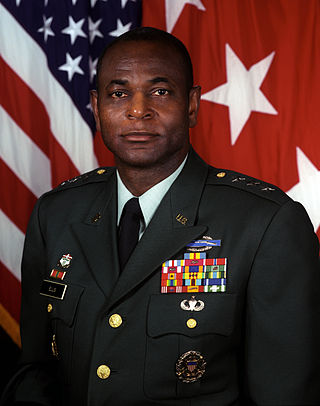
Larry Rudell Ellis is a former United States Army officer who served as the Commander of United States Army Forces Command from November 19, 2001 until 2004, following his assignment as the Deputy Chief of Staff for Operations and Plans of the Department of the Army.
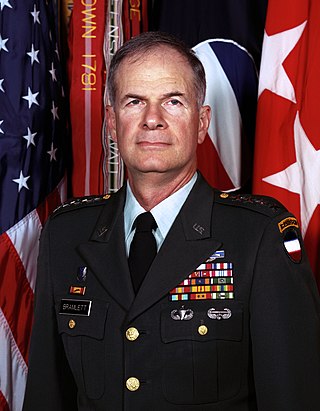
David Anthony Bramlett is a retired United States Army four-star general who commanded United States Army Forces Command from July 1, 1996 to August 31, 1998, after serving as Deputy Commander in Chief and Chief of Staff, United States Pacific Command at Camp H. M. Smith, Hawaii. During his tenure as Deputy Commander, he was the interim commander of Pacific Command after the commander, Admiral Richard C. Macke, came under fire for comments he had made in regard to the 1995 rape scandal in Okinawa that involved three United States servicemen.

Ronald Houston Griffith was an American general in the United States Army who served as Vice Chief of Staff of the United States Army (VCSA) from 1995 to 1997. He was born in Lafayette, Georgia.

William James "Lipp" Livsey was a United States Army general who served as the Commander in Chief of United Nations Command/Commander in Chief, ROK/U.S. Combined Forces Command/Commander, United States Forces Korea/Commanding General, Eighth United States Army from 1984 to 1987.

John Ember "Jack" Sterling Jr. is a retired United States Army lieutenant general. He served as Deputy Commander and Chief of Staff for United States Army Training and Doctrine Command (TRADOC) from 2010 to 2012, and was acting commander in 2011. He retired in June 2012.

Thomas Paul Bostick was the 53rd Chief of Engineers of the United States Army and Commanding General of the U.S. Army Corps of Engineers. Since the creation of West Point in 1802 as the Nation's first engineering school, Bostick is the only African American graduate of the academy to serve as the Chief of Engineers and Commanding General of the U.S. Army Corps of Engineers. Following his military career, Bostick served as the Chief Operating Officer and President of Intrexon Bioengineering. He serves on the Boards of CSX, Perma-Fix, Fidelity Investments' Equity and High Income Fund, HireVue, and Allonnia. He serves on the non-profit boards of Resilient Cities Catalyst and American Corporate Partners, a 501(c)(3) organization dedicated to assisting U.S. Veterans in their transition from the armed services to the civilian workforce. He is also a Forbes Contributor.
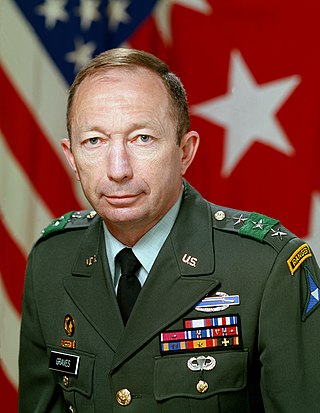
Richard Gordon Graves is a retired lieutenant general in the United States Army. He was Commander of III Corps and Fort Hood. He is a 1958 graduate of the U.S. Military Academy.

Major General Dennis K. Jackson is a retired general officer in the United States Army and served as the director for logistics, J-4, United States Central Command, MacDill Air Force Base, Florida. Prior to this assignment, he served as the 30th Chief of Ordnance and Commandant of the U.S. Army Ordnance School at Aberdeen Proving Grounds, Maryland.

Frederic J. Brown II was a career officer in the United States Army. A veteran of World War II, he was most notable for serving in senior command assignments, including the 3rd Armored Division, V Corps, Allied Land Forces South-Eastern Europe, Sixth United States Army, and the Army Logistics Systems Study Group. Brown attained the rank of lieutenant general and was a recipient of two awards of the Army Distinguished Service Medal, two awards of the Silver Star, two awards of the Legion of Merit, the Bronze Star Medal, and the Air Medal.




















